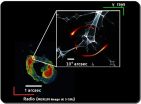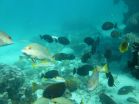Originally used by 19th-century photographers to create the illusion of depth in their pictures, stereomicroscopy since has evolved to become a staple of the film and videogame industries. Only recently has it become more prevalent in medicine, one factor that makes these findings particularly important.
Using 3D-pattern stereomicroscopy with mouse models, School of Medicine researchers reported that they able to develop entire topographical views of the inside of the intestinal system, rather than two-dimensional visuals of individual sections or tissue or cell samples. This more expansive and detailed picture allowed them to identify distinct patterns related both to health and disease within those structures - patterns that they could not see using traditional approaches.
As part of the study, the researchers developed a catalogue of specific profiles for abnormalities in those with inflammatory bowel diseases (IBD). Not only do these profiles provide a depth of information not attainable by other means, but they also can accelerate the process of determining the condition or illness that is plaguing the patient.
"This is really exciting for us because for the first time, we have a technique that provides a better way to examine these lesions," said senior author Fabio Cominelli, MD, chief of the Division of Gastroenterology and Liver Disease and the Hermann Menges, Jr. Chair in Internal Medicine, Case Western Reserve University School of Medicine. "The traditional, two-dimensional histology views do not tell us what is going on in the entire tissue. The precision of this 3D technology will allow us to visualize the location of lesions along the entire intestinal tract to learn the exact cause of the inflammation."
Cominelli, also director of the Digestive Health Institute at University Hospitals Case Medical Center, has assembled a team of investigators to focus research on inflammatory diseases of the digestive tract, particularly Crohn's disease, inflammatory bowel disease and ulcerative colitis. One of those team members, Alexander Rodriguez-Palacios, DVM, PhD, made the breakthrough possible by identifying a novel way to use a stereomicroscope, a device often used in microsurgery. Typically physicians have been limited to endoscopy or histology in studying these diseases; recognizing their shortcomings, the team sought other means of gaining better understanding of the nature of different diseases. The more they knew about different conditions, the thinking went, the more effective they could be in helping patients.
""Currently, we have treatments that can make the patient feel better, but we are not able to achieve a sustained positive response in patients," Cominelli said. "The goal for developing new therapies now is to have lesions disappear, or possibly prevent lesions from appearing in the first place."
Cominelli, Rodriguez-Palacios,and their colleagues set out to test the efficacy of this alternative approach by studying the inflammatory-diseased intestinal tracts of more than 800 mice from 16 strains of the animals. During the course of their study, the scientists saw distinct patterns of lesions develop in the different kinds of mice. These different patterns point to genetic origins for the various inflammatory intestinal diseases.
"What we saw were unique structural characteristics in inflamed tissue and in normal tissue," Rodriguez-Palacios said. "Before, a lesion was just a lesion. We found that these lesions had a particular configuration. Now we can tell the different kinds of lesions and patterns of lesions that make a difference in the disease. Nobody has ever done that before."
Through 3D microscopy, investigators found two mouse models that most resemble inflammatory bowel disease in humans. The SAMP mouse has cobblestone lesions typical of human Crohn's disease, and the TNF mouse has enlarged and distorted intestinal villa typical of inflammatory bowel disease. (Villa are finger-like projections protruding from the intestinal wall to aid in nutrient absorption.)
By studying both mouse models using 3D stereoscopy, investigators hope to make informed predictions about how these inflammatory bowel diseases develop and progress in humans. They also plan to observe the natural history of the illness, from early onset through end stages. They also aim to uncover what causes these intestinal diseases, what genes are expressed, underexpressed or overexpressed, and what intricacies are involved in the microbe environment of the gut.
"We will use the 3D stereoscopy to study these mouse models extensively to understand what causes the disease in mice," Cominelli said, "[and then] correlate that understanding to human patients and then develop new therapies."
INFORMATION:
Joining Cominelli and Rodriguez-Palacios in the research were Tomohiro Kodani, Lindsey Kaydo, Davide Pietropaoli, Daniele Corridoni, Jeffry Katz, and Theresa T. Pizarro, all of the Division of Gastroenterology and Liver Disease, Department of Medicine, Case Western Reserve University School of Medicine, and Wei Xin, of the School of Medicine's Department of Pathology, and the Digestive Health Institute, University Hospitals Case Medical Center.
This work received funding support from the National Institutes of Health grants DK091222, DK055812, and DK042191 and the Crohn's and Colitis Foundation of America via a Career Development Award.
About Case Western Reserve University School of Medicine
Founded in 1843, Case Western Reserve University School of Medicine is the largest medical research institution in Ohio and is among the nation's top medical schools for research funding from the National Institutes of Health. The School of Medicine is recognized throughout the international medical community for outstanding achievements in teaching. The School's innovative and pioneering Western Reserve2 curriculum interweaves four themes--research and scholarship, clinical mastery, leadership, and civic professionalism--to prepare students for the practice of evidence-based medicine in the rapidly changing health care environment of the 21st century. Nine Nobel Laureates have been affiliated with the School of Medicine.
Annually, the School of Medicine trains more than 800 MD and MD/PhD students and ranks in the top 25 among U.S. research-oriented medical schools as designated by U.S. News & World Report's "Guide to Graduate Education."
The School of Medicine's primary affiliate is University Hospitals Case Medical Center and is additionally affiliated with MetroHealth Medical Center, the Louis Stokes Cleveland Department of Veterans Affairs Medical Center, and the Cleveland Clinic, with which it established the Cleveland Clinic Lerner College of Medicine of Case Western Reserve University in 2002. http://case.edu/medicine

